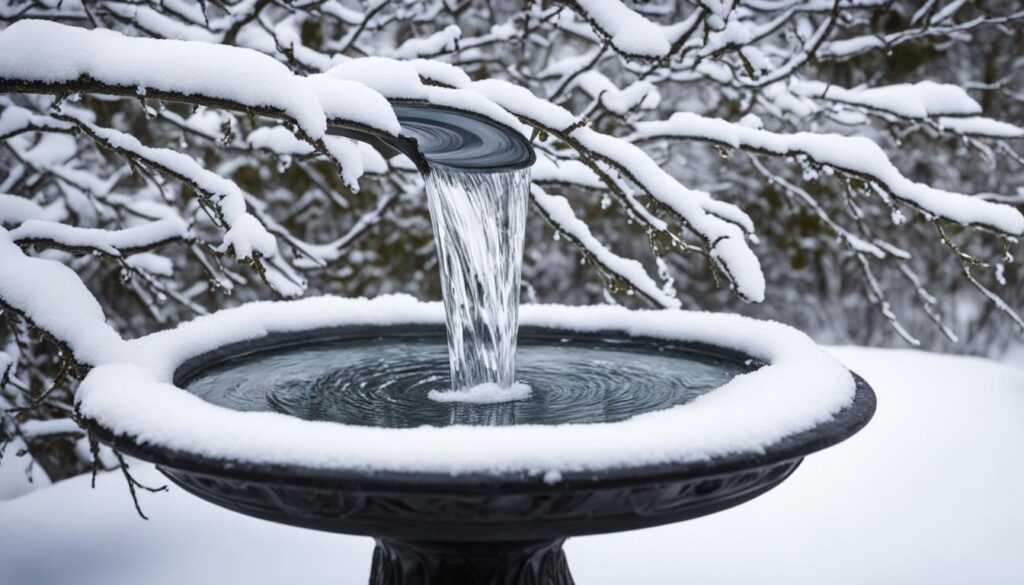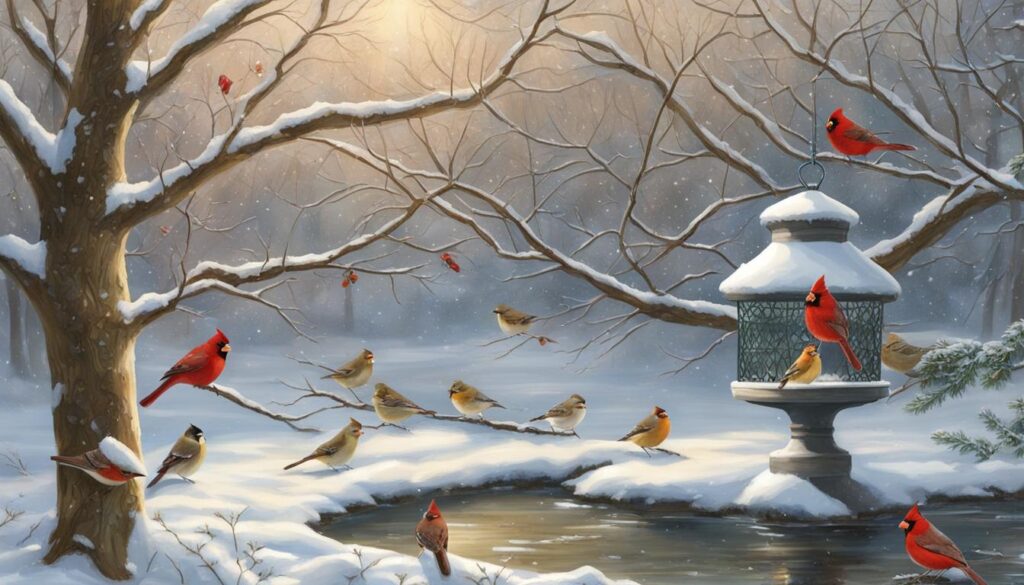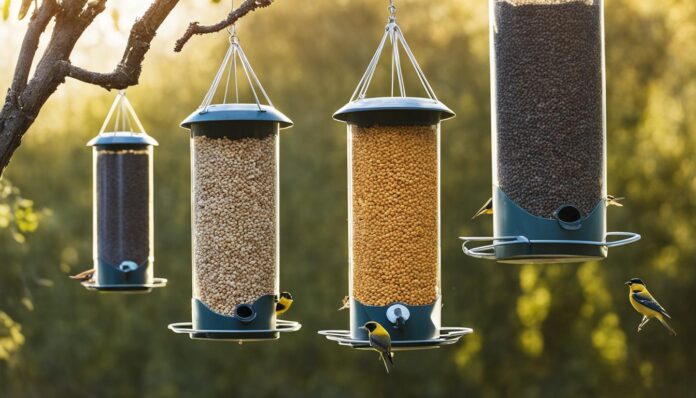Cleaning bird feeders and providing fresh water is crucial for supporting wildlife during the winter months. By maintaining clean feeding stations and providing a constant supply of fresh water, you can help birds and other wildlife survive the challenging winter conditions. This article will provide essential tips on how to properly clean bird feeders, the importance of fresh water for wildlife, and how these simple actions can contribute to wildlife conservation efforts.
Key Takeaways:
- Clean bird feeders are essential for the health and well-being of birds.
- Regular cleaning of bird feeders helps prevent the spread of diseases.
- Proper bird feeder maintenance includes removing old, moldy seed and debris.
- Providing fresh water is equally important as clean bird feeders for wildlife support.
- Use a heated bird bath or regularly replace the water to prevent freezing.
The Importance of Clean Bird Feeders
Clean bird feeders are essential for the health and well-being of birds. Dirty feeders can harbor bacteria, mold, and diseases that can be harmful to birds. Regular cleaning of bird feeders helps prevent the spread of diseases and ensures that the food provided is safe and nutritious for the birds. It is recommended to clean bird feeders at least once every two weeks, or more frequently if needed.
Proper bird feeder maintenance, including removing old, moldy seed and debris, is necessary to maintain a clean feeding station and promote bird feeder hygiene. By providing clean feeding stations, you are creating a safe environment for birds to eat and reducing the risk of them consuming contaminated food.
“Clean bird feeders help protect birds from diseases and provide them with a healthy food source.”
Regular cleaning also prevents the accumulation of bird droppings, which can attract unwanted pests like rodents and insects. Additionally, clean bird feeders contribute to a more aesthetic and enjoyable bird-watching experience.
The Dangers of Dirty Bird Feeders
Dirty bird feeders can have severe consequences for both birds and humans. Moldy or spoiled food can cause digestive problems and make birds more susceptible to illness. The close proximity of birds at feeding stations increases the risk of disease transmission, and the spread of diseases like salmonellosis can have devastating effects on bird populations.
“Birds rely on clean feeding stations for their survival and overall well-being.”
Furthermore, bird droppings found in dirty feeders can contain parasites and pathogens that can be harmful to humans. By maintaining clean bird feeders, you not only protect the health of birds but also minimize the potential health risks associated with disease transmission and contaminated environments.
How to Clean Bird Feeders
Cleaning bird feeders is a simple process that can be done using household materials:
- Start by removing any remaining seed and debris from the feeder.
- Wash the feeder using a mild soap and water solution. Pay attention to the crevices and hard-to-reach areas.
- Rinse the feeder thoroughly with clean water to remove any residue.
- Allow the feeder to air dry completely before adding fresh seed.
“Regular cleaning of bird feeders helps maintain a clean feeding station and ensures the health and well-being of the birds.”
It is important to avoid using harsh chemicals or bleach, as these can be harmful to birds. Clean bird feeders should be maintained year-round, not just during the winter months, to ensure the health and safety of the birds that depend on them.
How to Clean Bird Feeders
Cleaning bird feeders is an essential part of bird feeder maintenance and an important step in maintaining clean feeding stations and ensuring bird feeder hygiene. By following a few simple steps, you can keep your bird feeders clean and provide a safe and healthy environment for the birds that rely on them for food.
Here is a step-by-step guide on how to clean bird feeders:
- Step 1: Empty the Feeder
- Step 2: Scrub with Mild Soap and Water
- Step 3: Rinse Thoroughly
- Step 4: Air Dry Completely
- Step 5: Refill with Fresh Seed
Start by emptying the feeder of all remaining seed and removing any debris. Discard any spoiled or moldy seed, as it can be harmful to birds.
Use a mixture of mild soap and water to scrub the feeder. Pay close attention to any crevices or hard-to-reach areas where dirt, bacteria, or mold may accumulate. This will help ensure a thorough cleaning.
Rinse the feeder thoroughly with clean water. Make sure to remove all soap residue to prevent any potential harm to the birds.
Allow the feeder to air dry completely before refilling it with fresh seed. Ensuring that the feeder is completely dry helps prevent the growth of mold or bacteria.
Once the feeder is dry, refill it with fresh seed. Ensure the seed is clean and free of contaminants to maintain bird feeder hygiene.
Remember to avoid using harsh chemicals or bleach when cleaning bird feeders, as these can be harmful to birds. Stick to mild soap and water for a safe and effective cleaning process.
Cleaning your bird feeders regularly, at least once every two weeks, or more frequently if needed, is essential for maintaining clean feeding stations and promoting the health and well-being of the birds that visit your yard. By taking the time to clean your bird feeders, you are contributing to bird conservation efforts and playing a vital role in supporting local bird populations.
The Significance of Fresh Water

Providing fresh water is just as important as clean bird feeders when it comes to supporting wildlife during the winter. Natural water sources like rivers, ponds, and streams can freeze or become inaccessible to wildlife, especially during freezing temperatures. By providing a constant supply of fresh water, you can help wildlife stay hydrated and survive the winter.
It is recommended to use a heated bird bath or regularly replace the water to prevent freezing. Fresh water is essential for wildlife support and contributes to their overall well-being.
| Benefits of Fresh Water | Risks of Inadequate Water Supply |
|---|---|
|
|
Tips for Providing Fresh Water
During the winter months, providing fresh water for wildlife is essential for their survival and overall well-being. Here are some tips to help you ensure that wildlife has access to clean, fresh water:
- Utilize a Heated Bird Bath: Consider installing a heated bird bath to prevent the water from freezing. This will provide birds and other wildlife with a consistent source of fresh water.
- Regularly Monitor and Refill: Check the water source daily to ensure that it hasn’t evaporated or become contaminated. Refill the bird bath or water container as needed to ensure that wildlife always has access to fresh water.
- Maintain Clean Water: Remove any debris or contaminants from the water source regularly. Stagnant or dirty water can still pose a risk to wildlife. Keeping the water clean will help keep wildlife healthy.
- Secure and Accessible Location: Place the bird bath or water source in a safe and accessible location, away from potential predators. This will allow wildlife to drink and bathe without feeling threatened.
By following these tips, you can contribute to wildlife support by providing fresh water, helping them survive the winter, and promoting their overall well-being.
| Benefits of Providing Fresh Water | Challenges in Providing Fresh Water |
|---|---|
|
|
Winter Bird Feeding and Wildlife Conservation
Winter bird feeding serves as a vital way to support wildlife and contributes to the broader efforts of wildlife conservation. By providing food and water during the winter months, individuals can enhance the survival chances of birds and other wildlife that struggle due to scarce natural food sources. Such efforts can not only aid in the immediate survival of these creatures but also bolster population numbers in the long run. Moreover, winter bird feeding offers an excellent opportunity for people to connect with nature and cultivate a deeper appreciation for wildlife. By taking simple actions, such as cleaning bird feeders and providing fresh water, individuals can actively contribute to wildlife conservation.
“Winter bird feeding serves as a vital way to support wildlife and contributes to the broader efforts of wildlife conservation.”
Balancing Risks and Benefits of Bird Feeding

While winter bird feeding offers numerous benefits, it is important to understand and manage the potential risks associated with concentrated feeding stations. By taking proactive measures and following proper bird feeder hygiene practices, you can strike a balance that ensures the well-being of the birds and contributes to wildlife conservation efforts.
“Birds are attracted to feeders not just for food, but also for social interaction. However, the close proximity at feeding stations can increase the spread of diseases and attract predators.”
One of the primary risks of bird feeding is the potential transmission of diseases. When birds gather in large numbers, there is an increased chance for infections to spread. It is crucial to regularly clean bird feeders and remove any sick birds from the area to minimize the risk of disease transmission. This not only protects the health of the birds but also helps maintain a sustainable and thriving bird population.
Additionally, bird feeders that attract larger predators, such as squirrels or raccoons, can disrupt the natural behaviors and interactions of birds. These predators may pose a threat to both the birds and their eggs or nestlings. It is important to choose feeders and feeding methods that deter unwanted visitors, ensuring the safety of the birds while they feed.
“Balancing the risks and benefits of bird feeding involves responsible practices, such as regular cleaning, choosing appropriate feeders, and monitoring bird behavior.”
To mitigate these risks and maximize the benefits of bird feeding, it is recommended to:
- Regularly clean bird feeders with mild soap and water, ensuring the removal of any mold, bacteria, or debris.
- Provide multiple feeding stations spread out across your yard or garden to prevent congestion.
- Choose feeders that discourage larger predators and pests while allowing easy access for birds.
- Monitor bird behavior and remove any sick or injured birds from the feeding area.
- Hang feeders at different heights and locations to accommodate various bird species and their feeding preferences.
By being mindful of these risks and implementing responsible practices, you can enjoy the benefits of winter bird feeding while minimizing potential harm to the birds and supporting wildlife conservation efforts.
| Risks of Bird Feeding | Benefits of Bird Feeding |
|---|---|
| 1. Increased risk of disease transmission | 1. Provide supplemental food during food scarcity |
| 2. Attraction of larger predators | 2. Enhance bird-watching opportunities |
| 3. Disruption of natural behaviors | 3. Foster a sense of connection with nature |
| 4. Potential for overcrowding and competition | 4. Contribute to wildlife conservation efforts |
Creating a Wildlife-Friendly Habitat
In addition to cleaning bird feeders and providing fresh water, creating a wildlife-friendly habitat is crucial for supporting wildlife during the winter months. By planting native flowers, shrubs, and trees that provide food, shelter, and nesting opportunities, you can attract a diverse range of wildlife to your surroundings.
Native plants are adapted to the local environment and provide essential resources for wildlife. They attract insects, which serve as a vital food source for birds, mammals, and other animals. Additionally, native plants offer shelter and nesting sites, helping to create a balanced and sustainable habitat.
Here are a few key points to consider when creating a wildlife-friendly habitat:
- Choose native plants: Select species that are indigenous to your region. These plants have evolved with the local wildlife and are better suited to provide the necessary resources.
- Diverse plant selection: Include a variety of plant species to support a wider range of wildlife. Different plants provide different types of food and cover, attracting a greater diversity of animals.
- Plant for all seasons: Choose plants that bloom and produce berries or seeds throughout the year. This ensures a continuous food supply for wildlife, even during the winter months.
- Provide water sources: In addition to bird baths, consider installing a small pond or a container filled with water to provide drinking and bathing opportunities for wildlife.
- Create shelter: Incorporate native shrubs, trees, and dense vegetation to offer shelter and nesting sites for birds and small mammals.
- Minimize pesticide use: Avoid or minimize the use of pesticides in your garden, as they can be harmful to wildlife. Instead, focus on natural pest control methods or choose pest-resistant plant varieties.
Creating a wildlife-friendly habitat goes beyond attracting birds. It also contributes to the conservation of other wildlife species, such as butterflies, bees, and beneficial insects. By providing a diverse and sustainable habitat, you are playing an active role in wildlife conservation efforts.
Example of a Wildlife-Friendly Plant Selection
| Plant Species | Characteristics | Wildlife Benefits |
|---|---|---|
| Oak Tree (Quercus spp.) | Provides acorns as a food source | Attracts birds, squirrels, and deer |
| Red Yucca (Hesperaloe parviflora) | Drought-tolerant and produces nectar-rich flowers | Attracts hummingbirds and bees |
| Black-eyed Susan (Rudbeckia spp.) | Blooms in summer and produces seeds | Attracts butterflies, bees, and seed-eating birds |
| Serviceberry (Amelanchier spp.) | Produces berries and provides shelter | Attracts birds and small mammals |
| Butterfly Weed (Asclepias tuberosa) | Host plant for monarch butterfly larvae | Attracts butterflies and pollinators |
By creating a habitat that meets the needs of wildlife, you are not only providing essential resources for their survival but also fostering a deeper connection with nature. Your efforts in creating a wildlife-friendly habitat contribute to the overall well-being of wildlife and support ongoing wildlife conservation initiatives.
The Joy of Bird Feeding
Despite the risks and responsibilities associated with winter bird feeding, the joy it brings is immeasurable. There’s something truly magical about observing birds visit your feeders and witnessing their fascinating behaviors up close. As you provide support to these beautiful creatures, you not only enhance your connection with nature but also actively contribute to wildlife conservation.
By following best practices such as maintaining clean feeding stations and providing fresh water, you create an inviting environment for birds to thrive during the harsh winter months. The sight of colorful visitors and their melodious chirping can brighten even the dreariest of winter days, filling your heart with warmth and happiness.
Winter bird feeding also offers a unique opportunity for learning and discovery. You can enjoy the beauty of different bird species and their individual behaviors while gaining a deeper understanding of their needs and habits. It’s a rewarding and fulfilling experience to witness how your efforts in providing food and shelter can positively impact their lives.
FAQ
Why is it important to clean bird feeders?
Cleaning bird feeders is essential for the health and well-being of birds. Dirty feeders can harbor bacteria, mold, and diseases that can be harmful to birds. Regular cleaning helps prevent the spread of diseases and ensures that the food provided is safe and nutritious for the birds.
How often should bird feeders be cleaned?
It is recommended to clean bird feeders at least once every two weeks, or more frequently if needed. Regular maintenance, including removing old, moldy seed and debris, is necessary to maintain a clean feeding station and promote bird feeder hygiene.
How do you clean bird feeders?
Start by emptying the feeder of all remaining seed and removing any debris. Use a mixture of mild soap and water to scrub the feeder, paying close attention to any crevices or hard-to-reach areas. Rinse the feeder thoroughly with clean water and allow it to air dry completely before refilling it with fresh seed. Avoid using harsh chemicals or bleach, as these can be harmful to birds.
Why is fresh water important for wildlife?
Fresh water is crucial for supporting wildlife during the winter. Natural water sources can freeze or become inaccessible, especially during freezing temperatures. By providing a constant supply of fresh water, you can help birds and other wildlife stay hydrated and survive the winter.
How can I provide fresh water for wildlife?
Consider using a heated bird bath or regularly replacing the water to prevent freezing. It is important to keep the water clean and free from debris, as stagnant or dirty water can still pose a risk to wildlife. Place the bird bath or water source in a safe and accessible location, away from potential predators.
How does winter bird feeding contribute to wildlife conservation?
Winter bird feeding provides food and water when natural sources are scarce, improving the chances of survival and increasing the population numbers of birds and other wildlife. It also provides an opportunity for people to connect with nature and develop a deeper appreciation for wildlife. By cleaning bird feeders and providing fresh water, you actively contribute to wildlife conservation efforts.
What are the risks and benefits of bird feeding?
Concentrating birds at feeding stations can increase the spread of diseases, attract predators, and potentially disrupt natural behaviors. It is crucial to follow proper bird feeder hygiene practices, such as regular cleaning and removing any sick birds from the area. Balancing the risks and benefits of bird feeding is essential to ensure the well-being of the birds and the success of wildlife conservation efforts.
How can I create a wildlife-friendly habitat?
Planting native flowers, shrubs, and trees that provide food, shelter, and nesting opportunities can attract a diverse range of wildlife. Leaving natural areas untouched, providing nesting boxes, and creating wildlife-friendly landscapes can further support wildlife conservation efforts. By creating a habitat that meets the needs of wildlife, you help them thrive and adapt to the challenges of winter.
What is the joy of bird feeding?
Bird feeding is a rewarding and fulfilling experience. Observing birds visit your feeders, witnessing their behaviors, and providing support to these beautiful creatures brings immeasurable joy. By following best practices, maintaining clean feeding stations, and providing fresh water, you can enjoy the beauty of winter bird feeding while actively supporting wildlife conservation.

